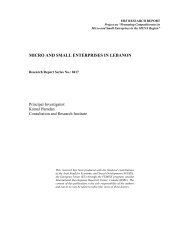local employment growth in the coastal area of tunisia - Economic ...
local employment growth in the coastal area of tunisia - Economic ...
local employment growth in the coastal area of tunisia - Economic ...
Create successful ePaper yourself
Turn your PDF publications into a flip-book with our unique Google optimized e-Paper software.
methods. Section 4 depicts statistical and econometric results, giv<strong>in</strong>g <strong>the</strong>ir economical<br />
<strong>in</strong>terpretations. Section 5 concludes.<br />
2. Tunisian context<br />
2.1 Goals <strong>of</strong> Regional Development Programs<br />
S<strong>in</strong>ce Tunisia ga<strong>in</strong>ed its <strong>in</strong>dependence <strong>in</strong> 1956, regional development has represented one <strong>of</strong><br />
its <strong>of</strong> ma<strong>in</strong> development goals. Such program’s goals should have led to <strong>the</strong> reduction <strong>of</strong><br />
poverty and <strong>in</strong>equality at global and <strong>local</strong> sides, <strong>the</strong> modernization <strong>of</strong> basic <strong>in</strong>frastructures,<br />
and <strong>the</strong> valorization <strong>of</strong> human resources. Such policies have enabled <strong>the</strong> manufactur<strong>in</strong>g sector<br />
to achieve real <strong>growth</strong> (reach<strong>in</strong>g 10.2%) 1 . However, regional <strong>in</strong>equality has not changed and<br />
<strong>the</strong> poor performance <strong>of</strong> <strong>the</strong>se programs has led policymakers to restructure <strong>the</strong> development<br />
programs <strong>in</strong> <strong>the</strong> sense <strong>of</strong> a genu<strong>in</strong>e regional policy, followed by <strong>the</strong> 10th development plan.<br />
Regional Development Strategy for <strong>the</strong> 10th Plan focuses on five key issues: (1) Improv<strong>in</strong>g<br />
<strong>the</strong> competitiveness between regions; (2) The streng<strong>the</strong>n<strong>in</strong>g complementarities between<br />
regions; (3) Improv<strong>in</strong>g <strong>the</strong> conditions <strong>of</strong> priority regions; (4) Improv<strong>in</strong>g <strong>the</strong> performance <strong>of</strong><br />
private sector; (5) Regional Decentralization Streng<strong>the</strong>n<strong>in</strong>g.<br />
Government <strong>in</strong>tervenes by promot<strong>in</strong>g decentralization and alleviates concentration along <strong>the</strong><br />
coast through legislation and regulations as well as through fiscal and monetary policy. S<strong>in</strong>ce<br />
1993, <strong>the</strong> Tunisian legislation allows some advantages for <strong>in</strong>vestments carried out by<br />
companies established <strong>in</strong> <strong>the</strong> deprived zones, def<strong>in</strong>ed as “priority zones”: 2<br />
Full tax exemption on pr<strong>of</strong>its for a period <strong>of</strong> ten years and a 50 % reduction on taxable<br />
ceil<strong>in</strong>g for ano<strong>the</strong>r ten year period;<br />
Full tax exemption on pr<strong>of</strong>its and re<strong>in</strong>vested ga<strong>in</strong>s;<br />
State coverage <strong>of</strong> a social security contribution (equall<strong>in</strong>g to 15.5 % <strong>of</strong> <strong>the</strong> salary) for <strong>the</strong><br />
first five years, and a partial contribution (from 20 % up to 80 %) for <strong>the</strong> next five years,<br />
for <strong>the</strong> work created out <strong>of</strong> projects be<strong>in</strong>g set up <strong>in</strong> priority regional development zones;<br />
Possibility <strong>of</strong> a state <strong>in</strong>volvement <strong>in</strong> <strong>the</strong> <strong>in</strong>frastructure expenditure.<br />
Efforts are mov<strong>in</strong>g <strong>in</strong> this direction to ensure <strong>the</strong> decentralization <strong>of</strong> <strong>employment</strong> from <strong>the</strong><br />
coast to <strong>the</strong> regional development zones such as Kasser<strong>in</strong>e, Gafsa, Siliana, and El Kef … and<br />
to develop logistic and transport <strong>in</strong>frastructure (see tables 6 and 7 for zone classification).<br />
2.2 Goals versus reality<br />
In opposition to <strong>the</strong> goals announced by <strong>the</strong> previous regional development program,<br />
Tunisian <strong>coastal</strong> <strong>area</strong>s and especially <strong>the</strong> Great Tunis rema<strong>in</strong> <strong>the</strong> ma<strong>in</strong> <strong>in</strong>dustrial zones. These<br />
efforts did not have <strong>the</strong> expected results, s<strong>in</strong>ce more than 90% <strong>of</strong> total <strong>employment</strong> is still<br />
produced <strong>in</strong> <strong>the</strong> <strong>coastal</strong> part <strong>of</strong> <strong>the</strong> country (Dlala, 1997). This configuration can be expla<strong>in</strong>ed<br />
by at least two factors. Firstly, Tunisia <strong>in</strong>herited a considerable <strong>in</strong>frastructure for production<br />
and distribution facilities concentrated <strong>in</strong> <strong>coastal</strong> zones, which had been set up by <strong>the</strong> French<br />
protectorate. Secondly, private capital <strong>in</strong>vestment, competitive poles, companies and jobs are<br />
characterized by a regional over-concentration along <strong>the</strong> coast (Figure 1). There is a relative<br />
immobility <strong>of</strong> human capital <strong>of</strong> <strong>coastal</strong> zones towards non-<strong>coastal</strong> ones.<br />
Concentration <strong>of</strong> <strong>in</strong>frastructures and human capital <strong>in</strong> <strong>coastal</strong> zones has facilitated <strong>the</strong><br />
development <strong>of</strong> <strong>in</strong>dustrial structures and services and consequently <strong>the</strong> relatively fast <strong>growth</strong><br />
<strong>of</strong> <strong>the</strong> Tunisian economy. Ayadi et al., (2004) argued that if <strong>the</strong> government had <strong>in</strong>vested a<br />
little more <strong>in</strong> <strong>the</strong> <strong>in</strong>terior zones <strong>of</strong> Tunisia ra<strong>the</strong>r than <strong>in</strong> <strong>the</strong> <strong>coastal</strong> zones, regional <strong>in</strong>equality<br />
have been reduced <strong>in</strong> broader proportions, but total <strong>growth</strong> would have suffered.<br />
1 National Institute <strong>of</strong> Statistics – Tunisia (INS).<br />
2 The Investment Code <strong>in</strong> Tunisia, Law No. 93-120 <strong>of</strong> December 27, 1993 - Act No. 2006-85 <strong>of</strong> December 25,<br />
2006, on F<strong>in</strong>ance Law for 2007 - Changes relat<strong>in</strong>g to <strong>the</strong> F<strong>in</strong>ance Act 2007.<br />
3

















